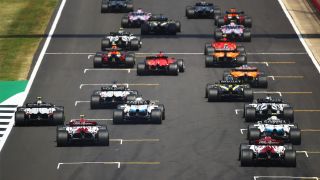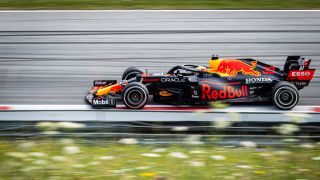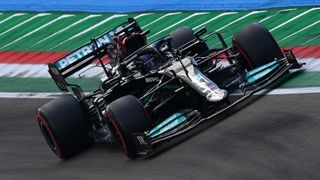What is F1 Sprint?
F1 Sprint is back in 2023 with some considerable changes

F1 Sprint is back for the third year in a row, and we're seeing yet more changes to the adrenaline-filled format. Of course, purists are still pushing back, but this year's updates look like they've addressed key concerns.
As the first change to the qualifying process since 2016’s short-lived and widely disliked Elimination Qualifying, F1 Sprint does have its fans. But to decide which side of the fence you are, you're going to have to first fully understand what it is.
So, if you’re not yet well-versed in this F1 update, here we’ll be explaining exactly what F1 Sprint is, who gets Pole Position, how it differs from the system we’re used to, and how to watch an F1 live stream to catch F1 Sprint on the day.
What is F1 Sprint?
Regular qualification for a Grand Prix works on a knockout basis over three rounds, all held on a Saturday.
All drivers take part in the first session, and the slowest five take places 16-20 on the final grid. The remaining 15 drivers take part in the second session, with grid spots 11-15 again taken by the slowest five. The last session sees the fastest 10 drivers compete for Pole Position, and the subsequent grid spots 2-10.
When Sprint Qualifying is on the cards, regular qualifying will still be held – although it will be moved back to Friday (in the place of Practice 2).
This year, Qualifying will determine Sunday's Grand Prix grid. This is a key change from 2022, where we saw Qualifying determine the Sprint's grid, and Sprint determined the GP's grid.
Get daily insight, inspiration and deals in your inbox
Get the hottest deals available in your inbox plus news, reviews, opinion, analysis and more from the TechRadar team.
On Saturday we have two sessions. The first is the all-new Sprint Shootout, which is effectively a condensed Qualifying session that determines the Sprint race's grid order. Sprint Shootout has three sessions, just like regular Qualifying:
- SQ1: 20 drivers, 12 minutes
- SQ2: 15 drivers, 10 minutes
- SQ3: 10 drivers, 8 minutes
The diminishing time on-track is intended to limit wear and tear on the cars, as well as impose a sense of urgency. Each driver is likely to only set two flying laps in each session, at best.
In the afternoon, the F1 Sprint race is held. Lining up in the order determined by Sprint Shootout, all drivers will race for 100km around the circuit in question, for a maximum of 8 points.
The short length is intended to provide a flat-out, exciting race for both drivers and spectators, in which teams won’t have to contend with pit stops for fuel or tyres.

How has F1 Sprint changed from last year?
This year's F1 Sprint changes are the biggest yet:
- Friday's Qualifying results determine the final grid order on Sunday.
- Sprint Shootout has been introduced
- Saturday is now self-contained, resembling a full race weekend in miniature
Some things have stayed the same, though. For example, the top 8 drivers in Sprint will still receive 1-8 points, rather than the measly maximum of 3 in 2021.
The Sprint race itself is also unchanged, meaning that the exciting, flat-out racing we've enjoyed over the last couple of years is still on the cards.
Who gets Pole Position in F1 Sprint?
Before F1 Sprint, the meaning of 'Pole Position' was easy to define: first place on the grid on Sunday, earned by setting the single fastest lap around the circuit in Qualifying. However, things have got a little confusing in the last couple of years. Buckle up...
In 2021, Qualifying determined the Sprint grid, and the winner of the Sprint race was awarded Pole Position and first place on the grid on Sunday. However, this meant that the holder of Pole Position may not have set the very fastest single lap – and this is often seen as a very different skill compared to winning a lengthy race.
In 2022, this was addressed by awarding the title of Pole Position to the winner of Qualifying. However, if that driver didn't win the Sprint race, they wouldn't start the Grand Prix in first position, despite still carrying the now honorary title of Pole Position. So, Pole Position was no longer synonymous with starting first on the grid. Still with us?
2023's changes appear to have returned a certain amount of logic to proceedings. Friday's Qualifying session determines Pole Position and the grid for Sunday's GP. F1 Sprint is now solely an entertainment and point-scoring activity, with neither of Saturday's session's results having any bearing on Sunday's grid.
Finally, 'Pole Position' now means what virtually everyone always assumed it to mean in the first place.

Where is F1 Sprint Qualifying being held in 2023?
This year F1 Sprint will make an appearance at twice the number of races, totalling six over the season:
- Azerbaijan GP – April 29
- Austrian GP – July 1
- Belgian GP – July 29
- Qatar GP – October 7
- US GP – October 21
- Sao Paulo GP – November 4
How to watch Sprint Qualifying
To watch the third run of F1 Sprint Qualifying, you’ll need to get yourself a live stream. To find out global viewing options, we highly recommend checking out our dedicated articles for every race, which outline global viewing options.
If you’re outside your home country when the Grand Prix is held, you may find that you can’t access your regular streaming service you use to watch the F1. However, there’s a neat trick to get around this – using a VPN.
All you need to do is sign up to a quality VPN – our first choice is ExpressVPN – and then change your location to back home. So, for example, if you’re currently in the US and want to catch the coverage on Sky Sports, all you need to do is select a UK server on the VPN, head over to the website, and start watching.
Mo Harber-Lamond is VPN Editor at Tom's Guide, and contributor for TechRadar. He focuses on cybersecurity content for Tom's Guide, and creates insightful content across the board to help readers make informed buying choices.

